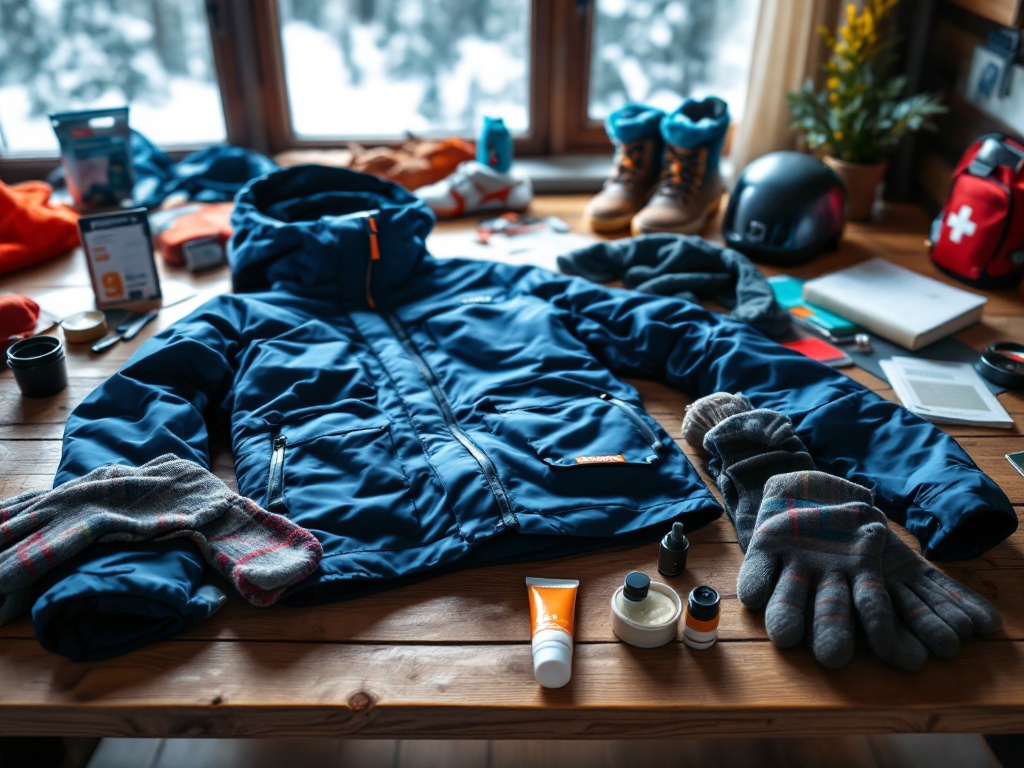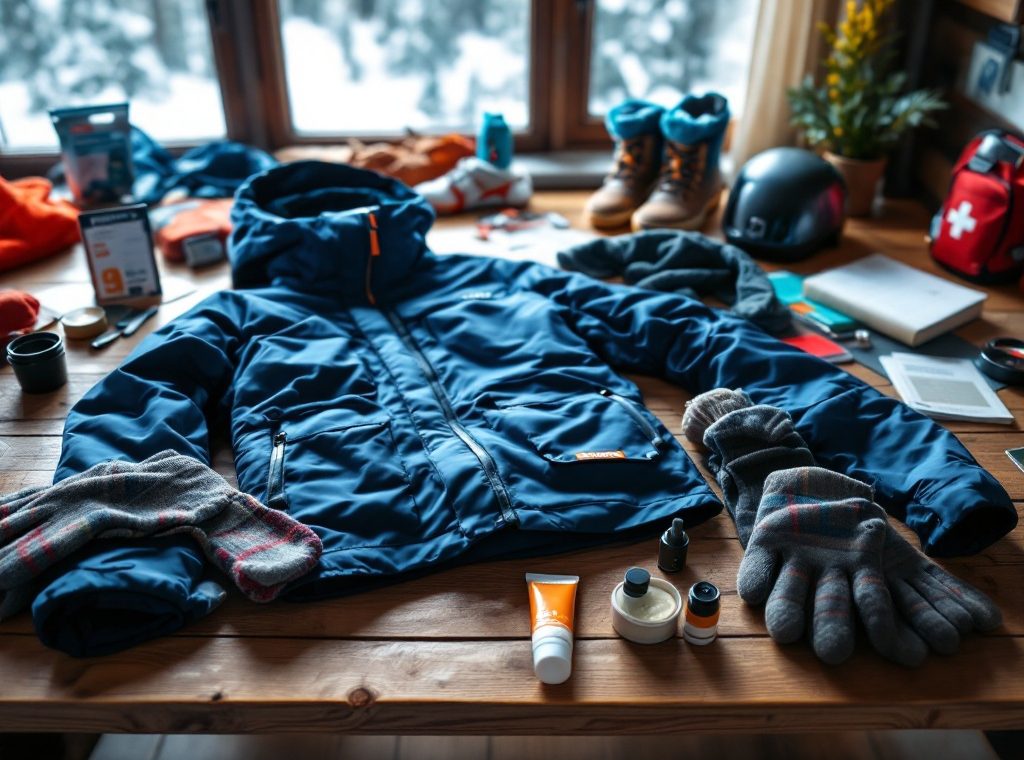What to Pack for a Ski Trip: Travel Essentials
Ready to conquer the slopes? From essential waterproof jackets and pants with a 10,000mm rating to breathable wool socks and versatile neck gaiters, discover the ultimate guide to ski and snowboard clothing. Learn the crucial layering system—base, mid, and outer layers—to adapt to fluctuating mountain weather. We’ll cover everything from choosing the right gloves or mittens to protecting your skin with SPF 30+ sunscreen and lip balm. Plus, get expert tips on packing essential safety gear, travel documents, and even a first-aid kit. Prepare for an unforgettable adventure on the mountain – read on to equip yourself with knowledge and confidence!
Important information

- Dress in layers: Start with moisture-wicking base layers (merino wool or synthetic), add insulating mid-layers (fleece or wool), and finish with a waterproof and windproof outer layer (ski jacket and pants).
- Protect your extremities: Wear insulated gloves or mittens, warm breathable wool ski socks, and a winter hat. A neck gaiter or buff adds extra protection.
- Essential gear includes skis/snowboard, boots, bindings, poles (for skiers), helmet, and goggles. A ski backpack is useful for carrying essentials on the slopes.
- Safety first: Always wear a helmet. For backcountry skiing, carry an avalanche transceiver, probe, and shovel.
- Don’t forget: Sunscreen, SPF lip balm, first-aid kit, travel documents, and insurance information are crucial for a safe and enjoyable trip.
Ski and Snowboard Clothing
Essential for skiing and snowboarding are waterproof jackets and pants, shielding you from the elements. Start with non-cotton base layers to wick away moisture, followed by a warm sweater for added insulation.
- Waterproof jacket and pants: These are your primary defense against snow, wind, and rain, keeping you dry and comfortable on the slopes.
- Non-cotton base layers: These garments wick away sweat, keeping you dry and warm even during strenuous activity. Opt for materials like merino wool or synthetic fabrics.
- Warm sweater: A mid-layer like a fleece or wool sweater provides crucial insulation, trapping heat and adding an extra layer of warmth.
Protect your hands with insulated gloves or mittens, and your feet with breathable wool ski socks. A winter hat is crucial for head warmth, while a neck gaiter (or buff) offers versatile cold-weather protection. For fluctuating conditions, pack an extra layer like a fleece vest.
- Insulated gloves or mittens: Keep your hands warm and protected from the cold. Mittens generally offer more warmth, while gloves provide better dexterity.
- Breathable wool ski socks: These socks will keep your feet warm and dry, preventing blisters and discomfort. Look for socks that are specifically designed for skiing or snowboarding.
- Winter hat: A warm hat is essential for retaining body heat, as a significant amount of heat is lost through the head.
- Neck gaiter or buff: This versatile accessory can be worn as a neck warmer, face mask, or headband, providing extra protection from the cold.
- Extra layer: Pack a fleece vest or a lightweight jacket for added warmth in case of changing weather conditions.
Base Layers
Base layers are crucial for regulating body temperature, wicking away moisture to keep you dry and comfortable. Thermal underwear, a prime example, is essential for skiing, providing warmth and dryness on the slopes. This not only maximizes comfort but also helps prevent cold-related issues, ensuring a healthy and enjoyable experience.
Mid-Layers
Mid-layers, such as fleece jackets or sweaters, are essential for warmth. They trap warm air close to your body while allowing moisture to escape, keeping you comfortable and dry. Their adaptability lets you easily add or remove layers as needed, which is crucial for handling the slopes’ changing weather and activity levels.
Outer Layers
Your outer layers are your first line of defense against the elements. Garments like ski jackets and pants shield you from snow, rain, and wind, keeping you warm and dry on the slopes. Waterproof and windproof materials are key for comfort and safety.
A quality outer layer is essential for a good experience on the mountain.
Waterproof and Insulated Clothing
Staying warm and dry is essential for enjoying skiing. Invest in a good ski jacket and pants with a waterproof rating of at least 10,000mm for optimal protection. Thermal base layers made of wool or synthetic fabrics—never cotton—are crucial. Boost your warmth with a mid-layer like fleece or wool, and don’t forget insulated gloves or mittens. A neck warmer or gaiter offers essential protection against the cold, while wool ski socks keep your feet toasty. A warm hat or helmet liner completes the ensemble. If you’re a beginner, consider renting ski jackets and pants to try out the sport without a large upfront cost.
Packing for Changing Weather Conditions
Packing for a ski trip requires a strategic approach due to unpredictable mountain weather. The key is layering, allowing you to adapt to fluctuating temperatures.
Start with a moisture-wicking base layer made of merino wool or synthetic fabric to regulate body heat.
Add mid-layers like fleece jackets or insulated vests for warmth.
Choose a waterproof outer layer, such as a ski jacket and pants, to shield you from snow, wind, and rain.
Pack extra mid-layers to adjust to daily forecasts.
Don’t forget essential accessories like waterproof gloves or mittens, which keep your hands warm and agile.
Layering Strategies
Dressing comfortably for skiing involves a three-layer system that adapts to changing weather conditions. Start with a moisture-wicking base layer to keep you dry. Add an insulating mid-layer for warmth. Finally, put on a waterproof outer shell to protect you from wind, snow, and rain. This adaptable system helps regulate your body temperature, ensuring a comfortable skiing experience.
Weather-Responsive Clothing
To fully enjoy your time on the slopes, dress in weather-responsive clothing, such as a waterproof ski jacket and pants. Layering is key for optimal comfort. Start with base layers to wick away moisture, add mid-layers for insulation, and finish with outer layers for protection from the elements.
Don’t forget essential accessories. Pack multiple winter hats for extra warmth, along with warm non-cotton ski socks to keep your feet dry and comfortable. Waterproof gloves or mittens are crucial for hand protection, and bringing both is a smart move for unpredictable weather.
Essential Ski Gear
Getting ready for a day on the slopes? Having the right gear is essential for a safe and enjoyable experience. Here’s a checklist to ensure you’re fully prepared:
Choose your ride: Skis or a snowboard, depending on your preference and skill level.
Secure your feet: Bindings and boots, ensuring a snug and comfortable fit.
Get a grip: Poles provide balance and control, especially for skiers.
Protect your head: A helmet is crucial for safety, minimizing the risk of head injuries.
Shield your eyes: Goggles offer protection from sun, wind, and snow, ensuring clear vision on the slopes.
Carry essentials: A ski backpack allows you to bring water, snacks, extra layers, and other necessities.
With the right preparation, you’ll be ready to hit the slopes with confidence and comfort.
Ski and Snowboard Equipment
Planning a ski or snowboard trip? Here’s the essential gear you’ll need:
For Skiers
- Skis,
- Bindings,
- Boots,
- Poles.
For Snowboarders
- Snowboard,
- Bindings,
- Boots.
Safety is paramount, so don’t forget these essentials:
- Helmet (crucial for both skiers and snowboarders),
- Goggles (protect your eyes from the elements),
- Ski bag (keeps your equipment safe during travel).
Stay hydrated on the slopes with a hydration pack.
Safety Gear and Accessories
Prioritize safety by always wearing a helmet for head protection. For backcountry skiers, avalanche airbags are essential safety equipment, significantly reducing avalanche fatalities in hazardous terrain.
Backcountry Skiing Equipment
Backcountry skiing requires prioritizing safety. Essential specialized equipment includes:
- an avalanche transceiver,
- a probe, and
- a shovel.
Your ski setup is also crucial and should feature:
- skis with touring bindings,
- climbing skins, and
- boots specifically designed for uphill travel.
Layered clothing is vital for adapting to fluctuating conditions. Finally, a well-packed backpack is indispensable for carrying essential gear, food, and water.
Toiletries and Personal Care Items
At high altitudes, the sun’s intense rays make sunscreen and SPF lip balm essential for protecting your skin. Aloe vera can soothe any unexpected sunburns. For daily hygiene, remember your basic toiletries:
- toothbrush,
- toothpaste,
- floss,
- deodorant,
- shampoo,
- conditioner,
- soap.
Personal items are also important:
- hairbrush,
- lotion,
- shaving supplies,
- cosmetics,
- nail clippers.
A small first-aid kit with pain relievers and blister treatment is recommended for hiking. Don’t forget any prescription medications and contact lens supplies if needed. However, glasses can be a more practical backup, as high altitudes can dry out contacts.
Protective Skincare
Shield your skin from the sun’s harmful rays with a sunscreen of SPF 30 or higher.
Reapply every two hours, especially after sweating.
Remember your lips too – use an SPF lip balm to protect them from sun and windburn.
During colder weather, moisturize your face with a cream formulated for low temperatures to prevent dryness.
Travel and Miscellaneous Essentials
Pack these essentials for a smooth ski trip: your passport or driver’s license, travel and medical insurance information, and ski passes, lift tickets, and resort confirmations. For your comfort, bring travel accessories such as a camera, headphones, chargers, a travel pillow, and a daypack. Don’t forget essential medications, a laundry bag, your mobile phone and charger, and a first-aid kit for safety.
Travel Documents and Insurance
Pack your passport or driver’s license for identification.
Don’t forget your ski passes if you plan on hitting the slopes.
Travel insurance is vital, covering medical expenses, trip cancellations, and even lost ski equipment.
For off-piste or backcountry adventures, consider supplemental insurance for added peace of mind.
Miscellaneous Travel Accessories
Pack a ski backpack with these essentials for a smooth trip: water, snacks, extra layers, a first-aid kit, tissues, hand warmers, camera, headphones, chargers, lift tickets, insurance, ID, and a Swiss Army knife for minor repairs. A sewing kit and shoe chains are also recommended for icy slopes.









